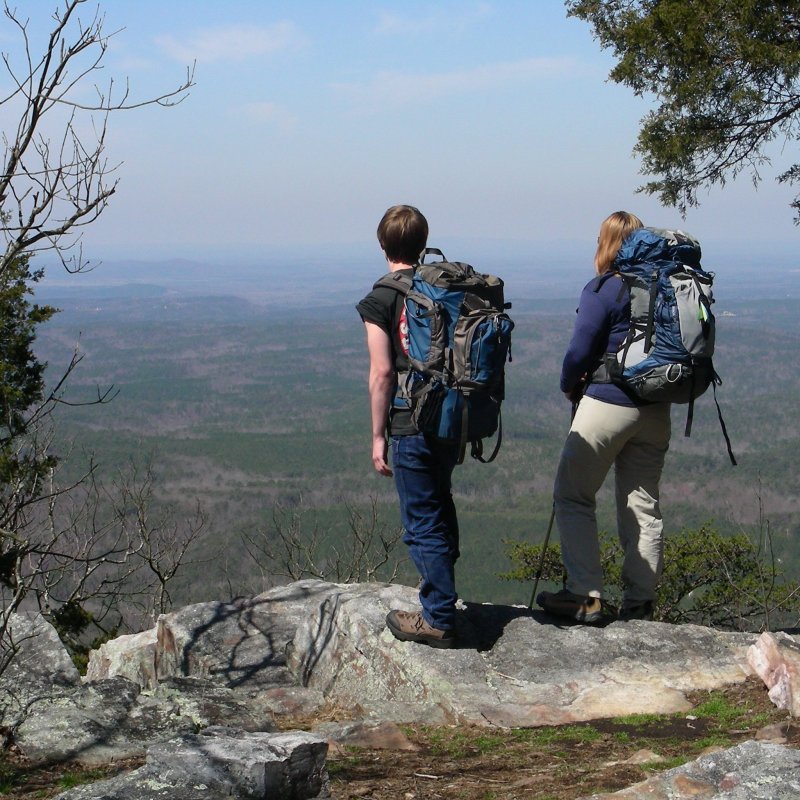
At one time or another, we all have dreams of going on a great adventure. For many, that dream is to one day hike the entire 2,100-mile Appalachian Trail (A.T.) from Georgia to Maine. But just as many (myself included) find that life gets in the way; work, family life, health issues, whatever it is, something prevents us from taking that million-step walk.
Videos by TravelAwaits
But there is an alternative, an equally challenging hike through the southern Appalachians — Alabama’s long path, the 171-mile Pinhoti Trail.
The Pinhoti Trail (or PT) stretches from the top of what is recognized as the last mountain over 1,000 feet all in the Appalachians, Flagg Mountain in Weogufkga, to the Georgia state line. The rocky, winding path follows the ridgeline of the Talladega National Forest, leading wanderers to beautiful streams, stunning waterfalls, and breathtaking views.
Being under 200-miles long, the trail is the perfect A.T. alternative (in fact, many people use the trail to train for hiking the A.T) without taking six months out of your life to hike it.
The Pinhoti Trail gives you plenty of hiking options: excellent day hikes, overnight loop hikes like the popular 17-mile long Skyway Loop, and section hikes, where you can hike any one of the Pinhoti’s 13 sections, each section averaging between 15 and 20 miles in length. And of course, and end-to-end hike of the entire trail.
No matter how you hike the Pinhoti Trail, it can make your dream of a true hiking adventure come true. Here are 11 tips for having a fun and safe hike on Alabama’s Pinhoti Trail.

1. Plan Your Adventure
Whether you take a short day hike or want the big adventure of thru-hiking the entire 171 miles, you always need to plan before setting one foot on the trail — the length of time you’ll set aside for the hike, the route you’ll hike, what you’ll carry like food and water, towns along the trail where you’ll resupply. The list seems endless.
Start your planning by visiting the Pinhoti Trail Alliance (PTA) website. Hugh “Solo” Hickman started the organization and website years ago and is the official go-to for all things Pinhoti.
2. Know How Long It Takes
The average hiker can walk 2.5 to 3 miles an hour. Of course, that also depends on your condition and stamina, but it’s a good base to calculate how long it will take to hike any trail.
For hiking PT from one end to another, most people plan on it taking two to three weeks.

3. Water Along The Trail
As Hugh Hickman with PTA says, “Anytime you use seasonal springs in your planning strategy, you are taking a risk.”
Truer words have never been spoken. There are several reliable water sources along the trail, as well as many springs. Those springs, however, are seasonal and dry up only a day after a decent rain.
Plan on carrying at least 2 quarts of water or more, then resupply at the next reliable source. Reliable doesn’t mean safe to drink. Always use a water filtration device when refilling your water bottles. Visit the PTA page for more information.
4. What To Pack Along
You have probably heard that hikers on the A.T. mail packages with resupply items to post offices along the route. No need to on the PT. Several towns along the trail (Oxford and Heflin in particular) are just a short distance from the path, so you can arrange for a shuttle (more on that in item 10) or have a friend meet you at a trailhead and drive you into town for a resupply.
Exactly what to pack is all a matter of preference. It also depends on the length of time you are going to be on the trail, how you like to camp (tent, shelter, hammock), and so on. Just remember to keep your pack as light as possible while bringing enough to stay comfortable on the trail.

5. Where To Stay
The easiest method of sleeping on the trail is by setting up camp at a trail shelter. These 3-sided buildings are scattered about the length of the trail and are available on a first-come, first-serve basis and can fill up quickly, so be prepared with alternatives.
Camping under the stars is all well and good until you wake up in the morning soaked with dew or caught in the rain. Always pack at minimum a tarp (and a method to hang it) or a lightweight backpacking tent.
Another great option, and one that is extremely popular today, are backpacking hammocks that you can sling between two trees but still have protection from mosquitoes and the elements.
You can pitch camp anywhere along the trail, preferably in an area that someone has already used as a campsite so as not to disturb the forest any further. If that’s not possible, then use the National Forest Services dispersed camping method.
Another option is the hostels just off the trail where you can spend the night in a cozy cabin then return to the trail the next day.
6. Navigation
Cell phone service can be spotty, if it exists at all, in many locations throughout the forest. Even if you carry a GPS, you should bring along a map and compass and know how to use them. Be sure to keep the map in a waterproof pouch.
The trail is marked with blue paint blazes. Wherever there is a turn in the trail, there will be two blazes, one on top of the other. The top blaze will be offset, either to the left or the right, showing you the direction of the turn.
7. Weather Along The Trail
Weather along the ridges of the Talladega National Forest runs the gamut from pleasant spring days with light breezes to severe thunderstorms and tornadoes in summer. You should check the weather before heading out.
It breaks the rule of trying to keep your pack as light as possible, but it’s not a bad idea to have a small, lightweight weather radio in your pack in case your phone doesn’t have a signal to check the forecast while on the trail.

8. Time Of Year To Begin
When you begin your hike is always a personal preference, but it’s safe to say that mid to late summer (June through August) is not the best time. Summer heat and humidity can be brutal.
While some people love the cold and hiking when there is a light dusting of snow on the ground in winter, the absolute best time is March and April, when moderate temperatures of around 65 in the day and 55 at night make hiking a pleasure. Colorful wildflowers line much of the path, and water sources are more plentiful.
Editor’s Note: If wildflowers set your eyes alight, we have plenty more on Alabama wildflower hikes.
9. The Shuttle Shuffle
Getting to the starting trailhead and leaving from the opposite trailhead can be as challenging as hiking the trail. You could do a “point-to-point” shuttle where you use two vehicles, parking one at the starting trailhead, the other at the endpoint.
Or contact one of the many shuttle services that can help you plan out your logistic needs — Coosa Hiker Hostel, Pinhoti Outdoor Center, and the Next Step Hostel and Shuttle Service.
Whatever you decide, arrange your ride well in advance.

10. Get Into Shape
Keep in mind that the Pinhoti, while not as long as the A.T. or Pacific Crest Trail, is still a long, rugged haul, and you need to be in reasonably good shape before hiking its entire length.
The complete trail is rated as being moderately difficult. For example, Section 5 has 14 rock gardens you have to scramble over (the PTA says, “with the proper attitude adjustment, plan on 2-hours to hike it”), and there is the dreaded Stairway to Heaven, a rugged half-mile climb from an elevation of 1,575 feet to 2,135 feet, where at times you will be climbing the rocks hand over hand.
Start your training well in advance with short practice hikes, gradually increasing your mileage and difficulty, even taking a couple of overnight treks to build up your stamina and endurance.
11. Safety First
Remember, you will be hiking in a national forest where hunting is allowed during season. Check the state’s Outdoor Alabama website for hunting season dates in the area. You can hike during these times, but always wear some hunter safety orange to be safe.
And remember, you will be hiking in a wilderness area where cell phone service can be spotty at best. You should never hike alone, but more importantly, always tell someone your plans – what time you are setting out on your hike, where you will start and end the trip, how long you plan on being on the trail, and when you expect to be off the trail. This way, someone will know when to expect you, and if something happens along the trail, they will alert authorities and send help.
Further Reading:
- Exploring The Appalachian Trail One Mile At A Time
- The Best Hikes In All 50 States
- TravelAwaits’ Favorite Hiking Shoes
- 8 Hikes In Alabama You And Your Dog Will Love
